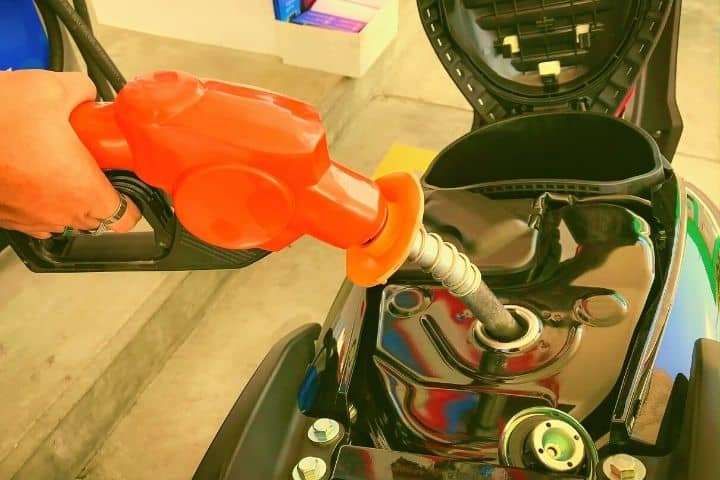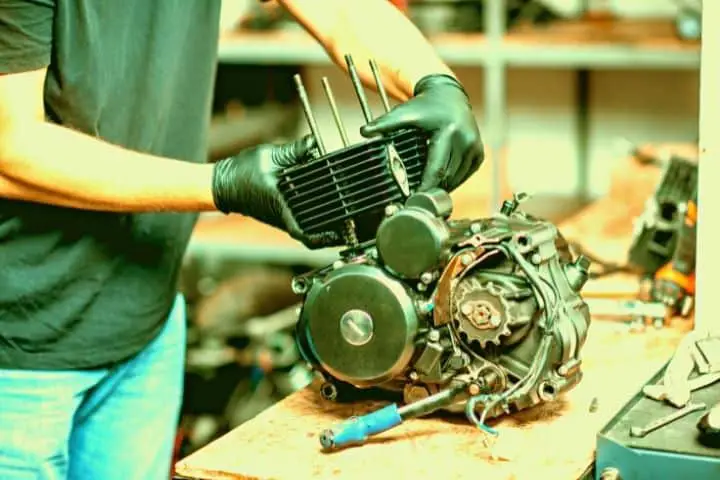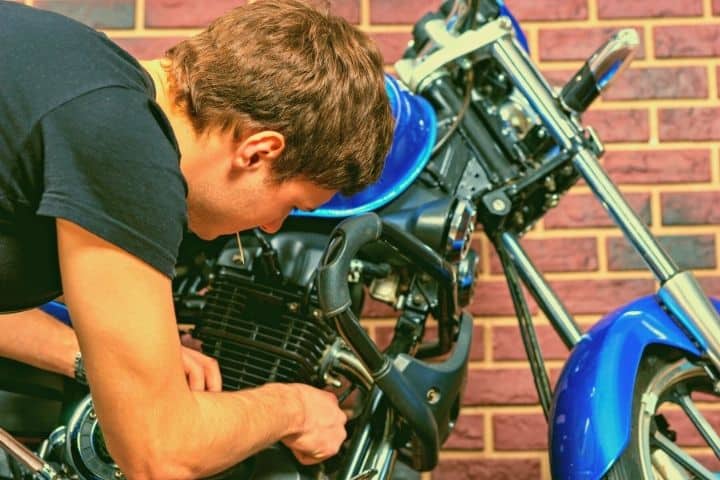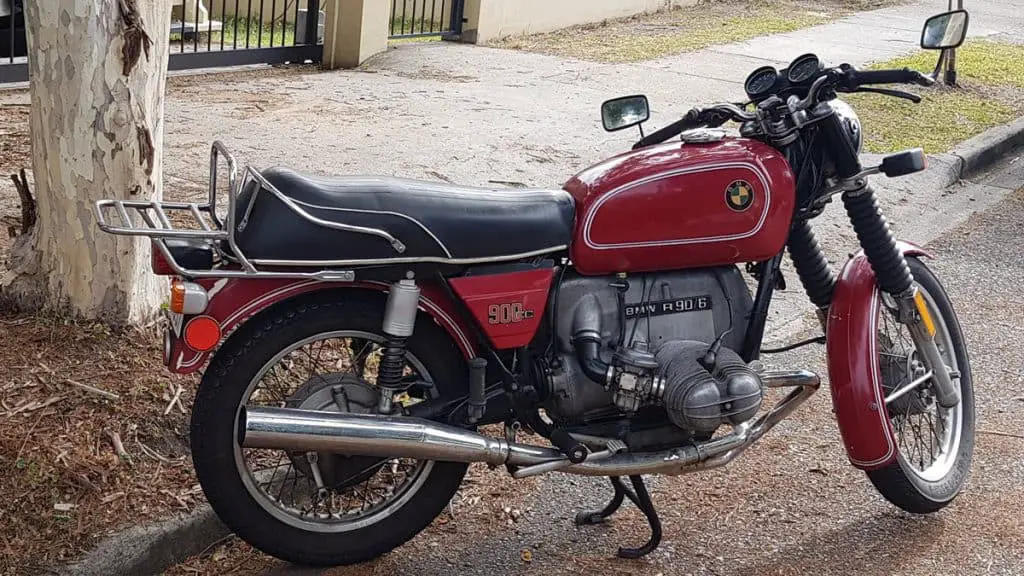Motorcycle Running Rich vs Lean: Symptoms & Signs (+ What to Do)
The ultimate rich vs lean discussion is NOT another political or economic topic you’ll be likely to hear these days.
Actually, it’s all about the air to fuel ratio (AFR) in the engine. That essentially means the right ratio of air and fuel to ensure complete combustion of the fuel.
If the ratio isn’t right, the engine won’t function at its best. And the results can be nothing short of destructive.
The good news is, in a motorcycle, identifying and rectifying the issue is much easier than in a car.
So let’s get down to business.
Which Is Better – A Lean or a Rich Mixture?

Here’s the thing…
When the combustion mixture has too much fuel and less air, it’s a “rich” mixture. When the scenario is the opposite, that is too much air and less fuel, it’s called a “lean” mixture.
To understand how this works, let’s first look at how fuel ratios work in the engine combustion chamber.
Time to pay attention. (Me pretending to listen should be enough for you.)
As you know, any fuel will need air to burn. But not just any amount of air! The correct ratio of air and fuel is essential for complete combustion of the fuel. Then exhaust will be free from any unburnt fuel and reduce emission percentages.
But in the real world, this is very difficult to pull off. IC engines hardly get a few milliseconds for the entire combustion process to take place.
For a gasoline engine, the ideal AFR (air-to-fuel) is 14.7:1. So, you need 14.7 parts of air for each part of fuel. This ideal mixture is called the stoichiometric mixture.
Keep in mind that the ratio differs from fuel to fuel. If you consider another fuel like methanol, the ratio changes to 6.4:1.

Now consider an AFR of 12.5:1. In this case, the AFR is lower than the stoichiometric ratio. So, it’s a rich mixture with more fuel and less air.
Likewise, for a mixture with a ratio of 17:1, the AFR is higher. So it’s a lean mixture with more air than fuel.
And yes, you will find AFR being mentioned as lambda (λ) in some technical platforms. (There’s even a lambda calculator.)
(I do have the talent to over-complicate things, don’t I?)
On a side note, the minimum air-fuel ratio is around 6:1 for the gasoline combustion process to occur. The maximum values can be around 20:1.
In older bikes with a carbureted fuel system, maintaining the right AFR can be even more challenging. With a more advanced fuel injection system, the amount of fuel delivered to the engine can be precisely controlled. This has made modern motorcycles incredibly efficient.
Now, AFR is not only linked with the tuning of engine performance, but it also affects the pollution levels from the exhaust. With the wrong AFR, you get more toxic gases coming out of the exhaust.
So is it better to run an engine lean or rich?
That’s like asking to choose between two supervillains.
Let’s find out the answer.
The Effects of a Lean Mixture

A lean mixture is more efficient but is more stressful for the engine. It also produces higher emissions and a higher volume of exhaust gases like nitrogen oxides. The lack of fuel particles also generates more heat in the chamber as the air can’t absorb as much heat as gasoline.
Here are the ways in which a lean fuel mixture will affect an engine.
- It can result in a condition called a hard seizure. Here the engine components get overheated and bend or snap due to the excess stress. This is catastrophic damage that will require replacing the engine.
- It can form a dry spot inside the engine and cause the components to run together. This will damage the components in the long run. And even if you shift back to a normal air-fuel mixture, the damage will still remain.
- If the mixture is too lean, you might find the engine failing to start.
The Effects of a Rich Mixture
A rich AFR mixture results in lower combustion efficiency as well as poor fuel economy. However, the combustion is cooler and the engine generates more power.
Question: will surplus fuel generate extra power?
Not really. As you make the mixture richer, there’s some extra power generated and a reduced chance of knocking in the chamber. Some brands that produce superbikes often follow this practice.
But then the ratio reaches a threshold and the effect is nullified. For unleaded fuel, this threshold is around an AFR of 12.5:1. So there’s no point in running too rich.
Here are the effects of a rich mixture.
- Since the unburnt fuel will move out of the exhaust, you will get fewer miles per gallon.
- There can be black smoke coming out of the exhaust. The carbon buildup from the fuel can also cause the blackening of the exhaust pipe edges.
- There can be carbon deposits inside the engine. This will lead to higher friction and cause damage to the engine components like the valves and the pistons.
- The unburnt fuel can get mixed with the multi-grade engine oil. This can lead to severe issues like reduction in the oil viscosity and reduced oil performance. As a result, the engine will overheat and there will be sludge deposits.
- It can result in engine stalling and increased vibrations. Another effect is rough idling.
So what does this mean?
Note, the primary enemy of ANY mechanical equipment is heat. No engine will last when it’s overheated.
If you really had to choose the lesser evil, a bike running with a rich mixture would be the better option.
The main reason is, a rich mixture won’t destroy the engine as thoroughly as a lean mixture. It will deliver less mileage and you’ll successfully annoy others on the road with a black exhaust fume.
Still, the engine will run cooler and it will not result in extreme heat damage within a short period.
Make sure to maintain your bike properly to ensure the right AFR ratio. If you go beyond certain values in either direction, you’re risking engine damage and poor performance.

What Are the Symptoms of Engine Running Rich?
A rich mixture can be caused by a blocked air filter. Since no air passes through it, there will be excess fuel in the combustion chamber.
(Sounds similar to a blocked nose!)
Other than that, a faulty fuel system or a malfunctioning oxygen sensor can also be the cause.
In addition, a malfunction in the ECU can also cause a variation in the air-fuel mixture. To fix this, you may need to get the computer reprogrammed by a professional.
Finally, check out some of the motorcycle running rich symptoms:
- A strong smell of fuel during startup. At times there’s also a rotten egg smell from the exhaust.
- Low fuel economy.
- Low performance from the engine as the valves fail to close fully due to the buildup of unburnt fuel.
- Deposition of carbon or black soot around the exhaust and spark plugs. In reality, spark plugs don’t remain clean on a bike. But a rich mixture can lead to extra deposition of soot.
- Due to high carbon monoxide generation, you may fail to pass an emissions test.
- In the long run, the catalytic converter can get clogged due to the deposition of unburnt fuel. As a result, the back pressure increases, and performance goes down.
What Are the Symptoms of Engine Running Lean?
In most cases, a rich mixture is caused by a malfunctioning fuel intake system. This will lead to low fuel delivery and a drop in fuel pressure.
Other than that, a malfunctioning oxygen sensor in the exhaust or a vacuum leak can also be a cause.
Time to take a look at some motorcycle running lean symptoms.

- A drop in the engine power output. You may also find it hard to accelerate.
- The engine will get overheated. In addition, the exhaust pipes can turn yellow or bluish.
- The engine might sputter and finally stall. It can also backfire while riding.
- If the spark plug has gray deposits around it, the engine mixture might be lean.
How Do I Fix My Running Rich or Running Lean Bike?
Firstly, if your motorcycle has a diagnostic tool, check the air-fuel ratio. That will help you to identify the problem.
In older bikes with a carburetor, fixing the problem is easy. All you need to do is turn a screw that adjusts the air-fuel mixture.
Since running lean is a more severe problem, let’s see how to fix it first.
- If the issue is due to clogged fuel injectors, you need to get the motorcycle inspected.
- In some cases, a vacuum leak in the lines can cause a lean mixture to form. Replacing the damaged hoses can be the only solution.
- Check the fuel pump and the strainer to ensure that they are functioning properly.
- In case the fuel filter is clogged it needs to be replaced.
- If there’s a problem with the oxygen sensor of the exhaust system, it needs to be rectified so that the ECU can receive the correct data.
If you observe signs of the fuel mixture running rich, some of the corrective measures are the same. These include checking the airlines and fuel injectors for leakage and replacing a faulty oxygen sensor.
Other than that, check the air filter for blockages and replace faulty spark plugs to ensure the right AFR.
Frequently Asked Questions

How does air-fuel mixture affect engine performance?
The air-fuel mixture plays an important role in determining the quality of the combustion. That combustion quality determines the energy output of the engine, heat generation, and gas emissions from the exhaust. So, controlling the right ratio of air to fuel is critical for tuning the engine for optimized performance.
Can running rich damage the engine?
Running rich isn’t as damaging as running lean. But in the long run, it will reduce the engine performance and life due to the formation of deposits. In addition, you will also get reduced fuel economy.
Is it better to run an engine lean or rich?
The fact is, neither is good for the engine. However, running lean can cause catastrophic engine damage within a short period due to excess heat generation. Running rich is not that drastic for the engine. Some manufacturers tune the bike to run slightly rich in some conditions.






